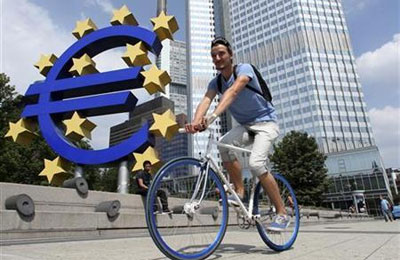
ECB studying models for bond purchases
FRANKFURT, January 10, 2015
The European Central Bank is considering a hybrid approach to government bond purchases which would combine the ECB buying debt with risk sharing across the euro zone and, in a nod to German qualms, separate purchases by national central banks.
Sources familiar with the discussions said such an option for bond-buying, also known as quantitative easing (QE), is among the tools the ECB is preparing ahead of its January 22 policy meeting should it decide to act to address falling consumer prices and a growing risk of deflation in the euro zone.
Several QE plans are under discussion and nothing has been decided so far.
The debate reflects the ECB's efforts to build a robust programme that meets German concerns about how much risk it would take on, yet also pleases investors anticipating an unlimited money-printing pledge.
Markets and many economists believe anything short of an unlimited money-printing will fail to revive a moribund euro zone economy and undermine the unity of the currency area.
But Paul de Grauwe, an economist with the London School of Economics, warned that any move to leave the responsibility and risk of bond-buying with national central banks posed a grave threat to the euro zone.
"This would be a kind of step towards the disintegration of the euro zone," he said. "It creates the perception that it is not fully unified ... that this is not a monetary union."
The ECB governing council discussed the current situation at a dinner on Wednesday night as it gathered for a regular non-policy meeting. One central bank source said there was "clearly more of a consensus than before" that QE might be necessary.
"On the rest, there are still pretty much divergent views on the whole range of issues - volume, open-ended or closed, risk-sharing or not, whether there are contingencies and which ones. It's still very open," the source said.
A volume of 500 billion euros was suggested by ECB experts in a presentation, another source added.
A third central bank source said one of the options that was discussed was one where the ECB would buy a certain share of the total programme and in case of default the risk would be shared among national central banks depending on their capital share.
The remaining part of the programme's volume would be bought by national central banks, but at their own risk.
"There was no fundamental opposition against this option on Wednesday," said the source. "This could be an option, which the Bundesbank could go along with." But the source said there was no decision yet and the discussion remained very much open.
Neither the ECB nor Bundesbank would comment.
The US Federal Reserve, the Bank of Japan and the Bank of England have turned to QE to revive their economies, but in the euro zone, which is more reliant on banks and which has no common fiscal regime, QE is more difficult to implement.
Germany's Bundesbank is one of the most vocal opponents of such a step as it fears the bloc's largest economy may end up paying for risk accumulated elsewhere. It is also concerned that QE could lower the incentive for crisis countries to reform.
Bundesbank president Jens Weidmann has said he saw currently no need for further stimulus even if consumer prices turned negative, as they did in December for the first time since 2009, while questioning also the effectiveness of QE.
One of the central bank sources said the German opposition to QE was softening "to some extent" due to the watering down of risk-sharing.
Under the Securities Market Programme, launched at the height of the crisis, the ECB and the national central banks bought government bonds from countries like Greece, Ireland and Portugal under the premise to share future profits and losses along the ECB's capital key.
This is again an option now, but hardly palatable for the Bundesbank, which suggested that national central banks should buy the debt of their own governments, confining the risk to the country in question.
The first central bank source expected a mixed system with some central ECB buying, but "a large part will be national central banks buying".
The second source said the ECB's share could, for example, be somewhere between 20 and 40 per cent. He gave a ballpark figure of 500bn euros for the overall size of the programme.-Reuters







